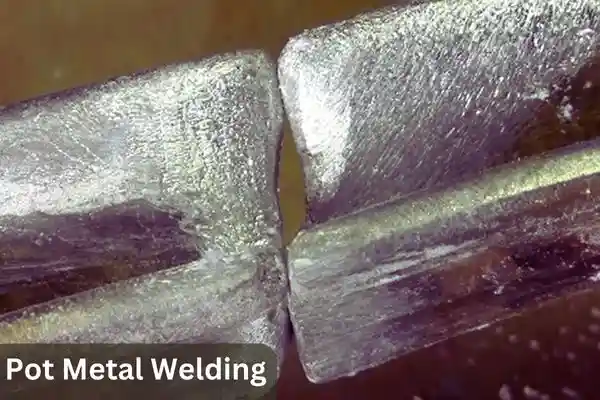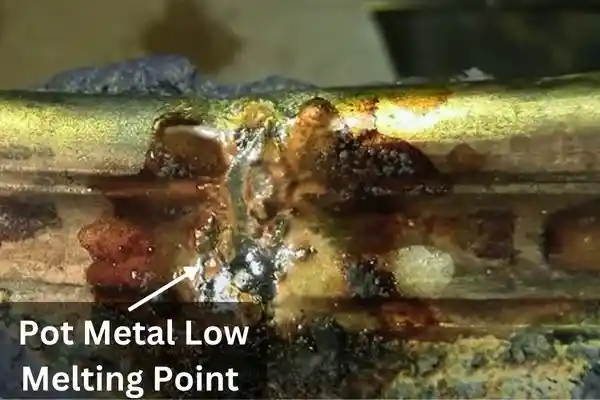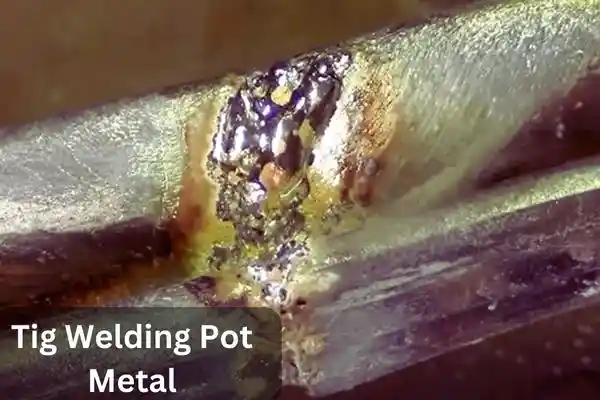Can You Weld Pot Metal? Factors & Possibilities
Updated: 15 Feb 2024
73
Welding is considered one of the leading and essential skills in metalworking and is effective against all metals, but there are certain metals, like pot metal, where things get a bit complex.
Yes, you can weld pot metal, but it’s more challenging than you think and is nearly impossible. It is because the pot metal has elements like zinc, which has a very low melting point and can’t withstand the extensive welding heat and starts melting before the process even begins.
Welding pot metal is challenging but not impossible, and in all welding methods, only TIG welding is suitable for welding it. Welding pot metal with TIG welding needs proper safety precautions. You can also use other alternatives for joining pot metals instead of welding.
What is Pot Metal?
Pot metal is a casting alloy commonly composed of lead, tin, zinc, and other elements, which is cheap compared to their metal and famous for its low melting point, making it suitable for casting. Due to the low casting factor, you can make a lot of different items, mostly for decoration and household.
The composition of pot metal varies from one element to another, but zinc will always be found in every pot metal, and it acts as its primary metal. It also has other metals like tin and lead, which enhance its overall properties but can introduce a challenge during welding. It has impurities, such as casting defects and oxides, which complicate the welding process and affect the final weld’s integrity.
Can You Weld Pot Metal?

Yes, you can weld pot metal, but it’s nearly impossible. It has a low melting and boiling point, and many other factors present challenges that make it hard for welding. Although you can weld with the TIG welding method, you have to make a lot of effort, and only then can it become the welding you need. There are a lot of factors that make pot metal hard to weld, and they are given below.
Low Melting Point:
The pot metal has a very low melting point, usually less than 900F (482C). When exposed to high temperatures, these melting points make it susceptible to deformation and melting. That’s why you can’t weld it; it starts deforming and melting as soon as the welding process starts.

Content of Zinc:
Zinc is the main metal alloy in pot metals and has a very low boiling point compared to other pot metals. Zinc vaporizes easily whenever exposed to high temperatures. During the welding, it vaporizes easily and creates zinc fumes, which cause porosity and weak welds.
Alloy Variability:
Most of the pot metal has a different composition and varies from one pot to another. The presence of different alloy metals in the pots shares unique mechanical properties that react very differently to the welding process. The different compositions in pot metal make it hard to establish universal welding techniques that will work on all pot metal.
Corrosion and Oxidation:
Most pot metals are susceptible to corrosion and oxidation, especially when heated to a certain degree. That’s why it will hinder the welding process, which can later affect the whole welding quality.
Limited Welding Techniques:
Most traditional welding involves high temperatures like stick and MIG welding, but these welding methods are not suitable for pot metals; in fact, most of the welding methods are not suitable for these pot metals. You can only weld pot metal with TIG welding techniques requiring specific skills and equipment.
Heat Sensitivity:
Pot is a heat-sensitive metal, so you can’t be exposed to hot temperatures, which may affect its structure. It is also affected by rapid cooling, which may lead to thermal stresses, which then cause the metal to distort or crack.
How to Weld Pot Metal:
Welding two different pot metals into one is impossible, but it’s still doable. First, you must specify or identify the metal combination in pot metal and then find its melting and boiling point because they are heat sensitive. After knowing its details, you have to choose a proper welding method that applies to pot welding.
For that, there is only one welding method that is suitable for it, and that is TIG welding. TIG welding is precise and effective against pot metals. Then, decide and choose the required level of electricity based on the metal combination that starts welding. But before starting the process, clean the welding metals so they’re clean of porosity.

There are also other techniques that you can use to join two pot metals. There are two famous ones: Cold metal stitching and adhesive bonding, which don’t need excessive heat to join metal and are suitable for pot metal.
FAQs
Can Pot Metal be repaired?
Yes, you can repair pot metal. You can repair it with welding or use other techniques to restore the broken pieces.
Can Pot Metal be Welded to Steel?
No, it can’t be welded to steel because the pot metal has a very low melting point, while steel has a very high melting point, which is why it can withstand that much heat, not even less than its melting point.
Why can’t you Weld Pot Metal?
This is because pot metal is brittle and has a low melting point, which can’t withstand the extreme heat of a normal welding process. It is also not good for thermal stress and mostly exposes cracks.
Conclusion:
Welding pot metal is indeed possible, but it’s nearly impossible. But if you have the right techniques along with its safety precautions, then it may be easier than you think. But before you start welding, you need to understand the unique properties of pot metals and what challenges they pose while welding.
I hope you understand the full process, but if you have any questions, then ask them in the comment section, and we’ll answer them as soon as possible.
Please Write Your Comments